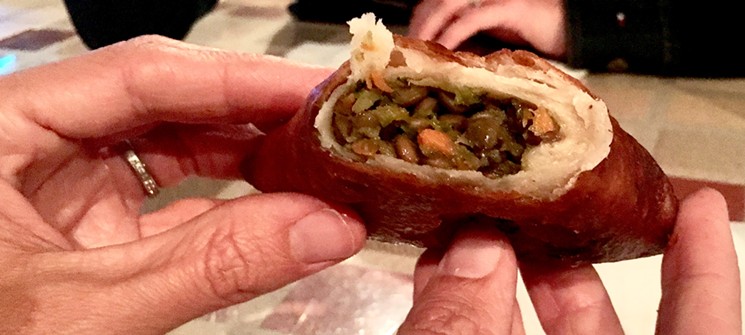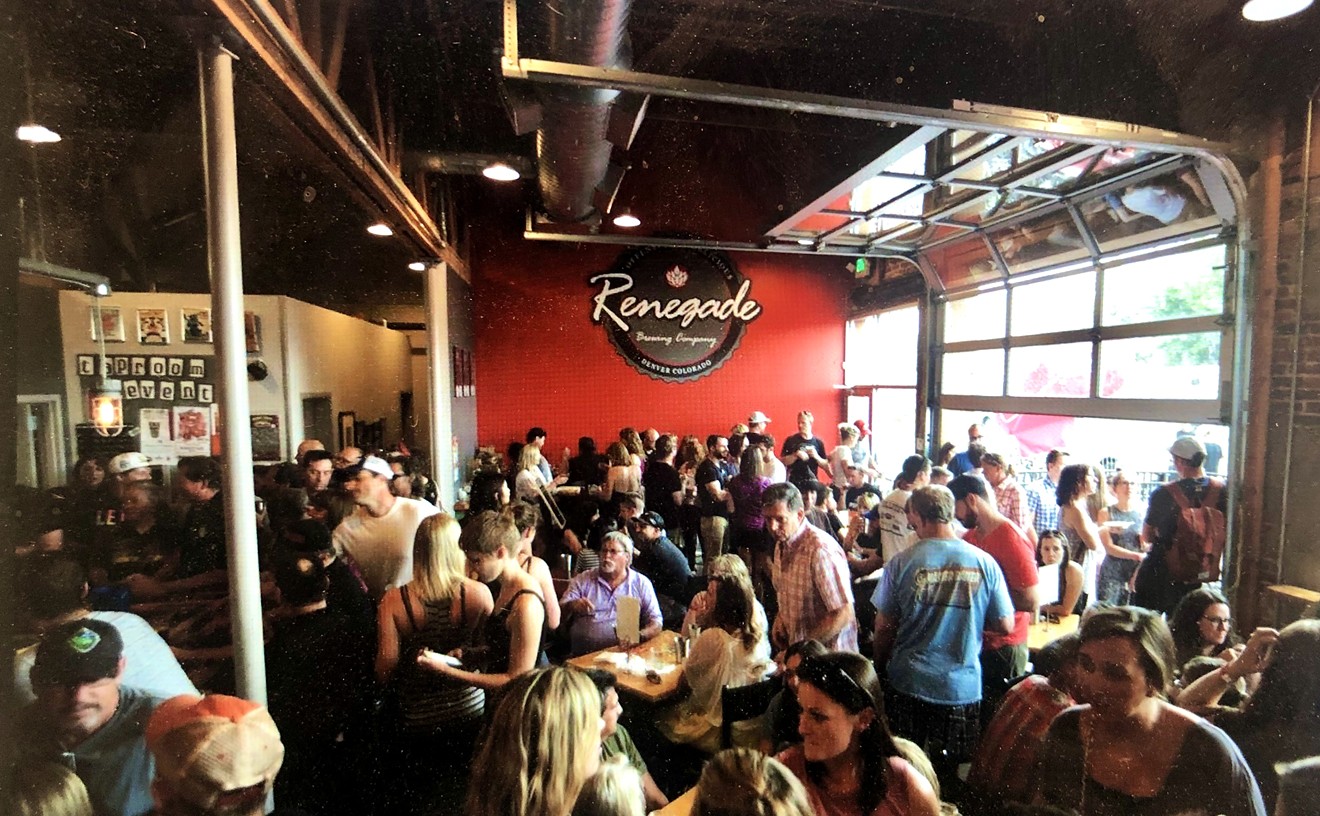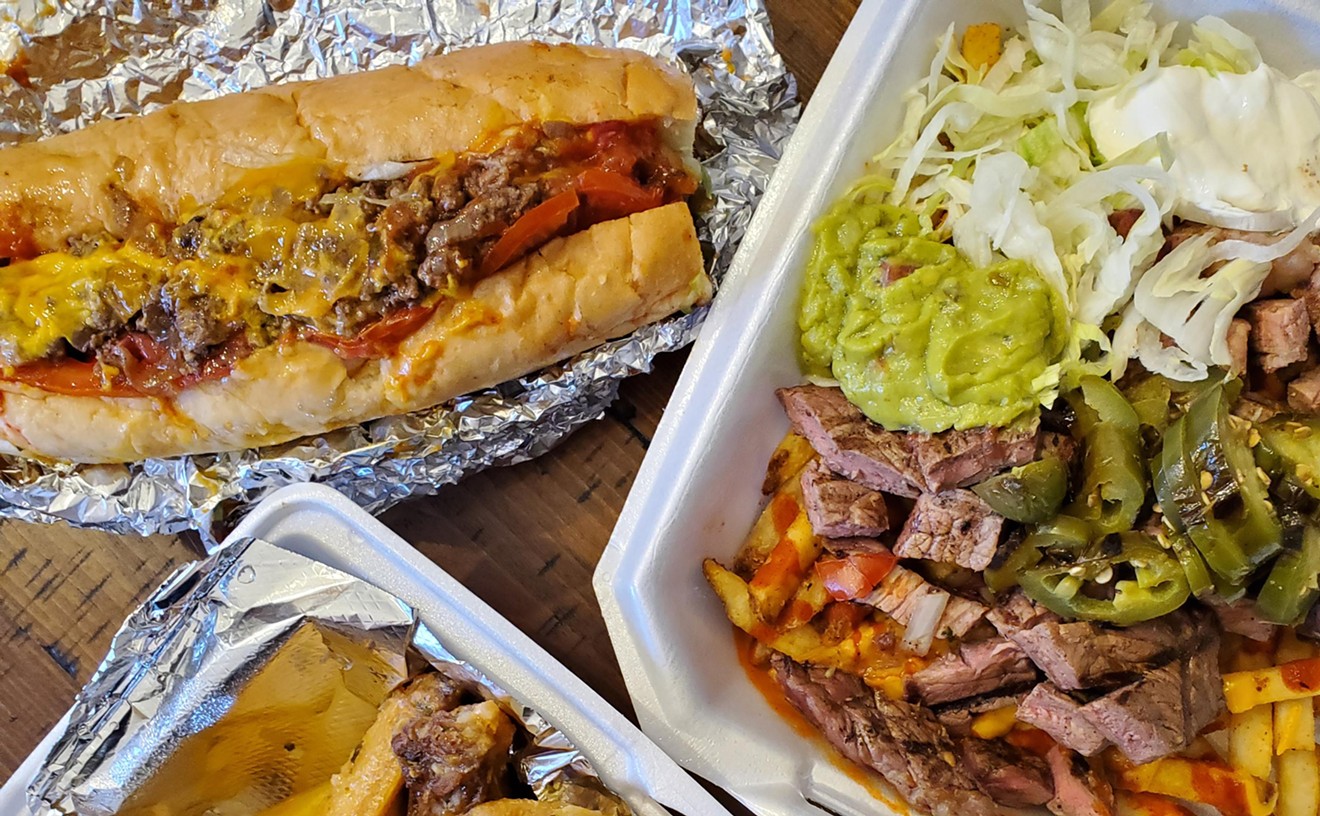When my dining companions and I walked into Addis Ababa Ethiopian Restaurant for a recent dinner, the entire place was dark, empty and a bit dingy. The waitress looked surprised to see us and seemed even more surprised when I asked to be seated for dinner instead of telling her we were lost and seeking directions. In fact, as I looked around, I wondered what the heck we -– a threesome of Caucasian women from the ’burbs -– were doing in this hole in the wall at 2222 South Havana Street.
For starters, decor is not the restaurant’s top priority. The tables, covered in cracked plastic covers, were a little sticky. The walls appeared dirty, and I found myself feeling grateful that the lights were dimmed so that I couldn’t see anything else that I didn’t really want to. The waitress told us to sit anywhere we wanted, so we chose a table away from the bar, where the tiniest bit of light shined so we could see the already hard-to-read menu.
Right off, I ordered a St. George Ethiopian Beer ($4.50) and some sambusas ($1.50 a piece). Like samosas (their Indian counterpart), sambusas are triangular, pastry-like pockets filled with lentils, carrots and onions, then lightly fried in butter. To be honest, I wasn’t expecting much after my first impression of the restaurant, but I was caught off guard by how flavorful these little pillowy treats were and how great they tasted alongside the sour-ish beer. The outer layer of the sambusa was perfectly browned, crunchy on the outside and soft and flaky on the inside. And the fact that the chef was able to make something as simple as lentils taste so smoky, rich and meaty instantly reversed my initially skeptical perception of the place.
If you’re an Ethiopian food virgin, as I was, you should know a few things before venturing out. In Ethiopian culture, sitting together and sharing a meal literally means you share it, and you’ll most likely be sharing it with your bare hands; you won’t get a plate or eating utensils. (Note: if you’re a germophobe, then bring a Purell wipe for you and your dining companions.) You will, however, get napkins and unlimited injera, a tart, spongy flatbread made from teff flour that you can tear into pieces to scoop up bites of the meaty stews and pungent veggie and lentil curries.
Even though my dining companions and I ordered individual dishes, our server first brought out my vegetarian combination plate, yetsom beyaynetu, ($10.99). The platter looked like a painter’s palate of thick, chunky stews and curries made up of vegetables, beans and lentils in gold, jade, crimson and orange that were spooned onto a large piece of injera and served on a huge silver platter.
This became the community platter, because every dish that came out after mine were also spooned onto it. The waitress brought out the awaze tibs ($11.99), chopped lamb marinated in red wine and sautéed in a bath of clarified Ethiopian butter, garlic, ginger, red onion and a sauce made with berbere (a mix of paprika and other spices). She took part of the tibs and dumped it right out in the middle of my vegetarian combo platter so that we could all share.
The last item that came out was the doro wot ($10.99), slow-cooked chicken (a leg, in this case) and boiled egg simmered in berbere, onion and butter, that was poured right out — bam! —in between the awaze tibs and the golden vegetarian stew. Once all the orders arrived and were literally dumped on the platter in front of us, we were given a basket of rolled up injera. We grabbed the edible silverware and began tearing off pieces and shoveling bites of these colorful mixtures into our mouths. I have to admit, Ethiopians are on to something, because the dishes were good on their own, but mixing them together in this way created a new taste experience with each combination of stews and curries I pinched up in my injera. Not only is it a new flavor with each bite, it’s fun to mix and match and see what combinations you like best.
A word of beginner advice: When you order, ask the waitstaff about spice levels before making a decision. If this is your first frolic with Ethiopian food, I don’t recommend attempts to be macho. We all have a different spice tolerance, but when the waitstaff at Addis Ababa says something will be spicy, they’re not playing around. My vegetarian combination platter had a few stews that were medium spicy or not spicy at all, while my friends' choices were described as a medium level of heat, and they admitted they were glad we were sharing our meals so that they could give their mouths a burn break with the mild curries and sauces on the vegetarian combo platter. If you end up ordering something a little too spicy at Addis Ababa, with no other dishes to help dull the pain, the Ethiopian beer and injera come in handy.
If you’re not a vegan/vegetarian (the menu offers options for both), I recommend trying a variety of chicken, lamb and vegetarian selections. Go with friends to sample an array of entrees or order a combination plate ($10-$14). The lamb and chicken glisten with rich, buttery, brick-colored sauces that have a good amount of spice, and the meat is tender and satisfying.
While we ate, the waitress and the cook sat together at the back of the restaurant and enjoyed a traditional Ethiopian coffee ceremony. The cook lit some incense and served both herself and the waitress the coffee she had just brewed. They sat knee-to-knee, talking intimately between themselves for about twenty minutes while we enjoyed our meal. When the coffee ceremony was finished, a thick, smoky incense smell permeated the air and helped make our experience seem more authentic. It soon became as normal as the background buzz of the Ethiopian music videos they had playing on repeat on both TVs.
Judging by what looked like regulars coming in to pick up takeout, it occurred to me that Addis Ababa serves as a meeting place for expats. Friends, family and tradition come first in Ethiopia. At Addis Ababa, whether you’re sharing a meal or sipping a cup of coffee, you make time to slow down and enjoy it with your companion, savoring a moment to be present with food and friends. The staff at Addis Ababa knows this and will not only facilitate with great food and drink, but they’ll demonstrate for you as well.
Addis Ababa is located at 2222 South Havana Street, B2 in Aurora and is open from 11 a.m. to midnight and beyond seven nights a week (the restaurant lists 2 a.m. every night but Sunday, but we haven't stopped by that late to see who's there). For more information or to place takeout orders, call Addis Ababa at 303-368-8021.
Four years ago, we profiled every restaurant on Federal Boulevard in our Federal Case series. Now we're doing the same on Havana Street, from East Hampden Avenue up to I-70. Join us on our journey of one of the city's most diverse culinary stretches.
[
{
"name": "Air - MediumRectangle - Inline Content - Mobile Display Size",
"component": "12017618",
"insertPoint": "2",
"requiredCountToDisplay": "2"
},{
"name": "Editor Picks",
"component": "17242653",
"insertPoint": "4",
"requiredCountToDisplay": "1"
},{
"name": "Inline Links",
"component": "18838239",
"insertPoint": "8th",
"startingPoint": 8,
"requiredCountToDisplay": "7",
"maxInsertions": 25
},{
"name": "Air - MediumRectangle - Combo - Inline Content",
"component": "17261320",
"insertPoint": "8th",
"startingPoint": 8,
"requiredCountToDisplay": "7",
"maxInsertions": 25
},{
"name": "Inline Links",
"component": "18838239",
"insertPoint": "8th",
"startingPoint": 12,
"requiredCountToDisplay": "11",
"maxInsertions": 25
},{
"name": "Air - Leaderboard Tower - Combo - Inline Content",
"component": "17261321",
"insertPoint": "8th",
"startingPoint": 12,
"requiredCountToDisplay": "11",
"maxInsertions": 25
}
]















